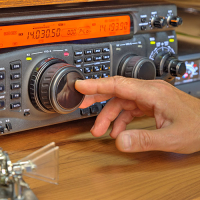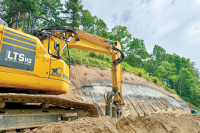A life in the rapids
By Jennifer Garlesky •Staff Writer
The raging Class II rapids of the Cacapon River, which flows along the eastern panhandle of West Virginia, hooked Doug Woodward on whitewater paddling.
The year was 1959 and the Georgia Tech student convinced his roommate to brave the wild West Virginia river. It was this experience that captivated Woodward and set him on course to become an expert paddler. His expertise would land him a job as a stunt man for the 1972 film “Deliverance” and later led him to teach paddling to former President Jimmy Carter.
“It really grabbed me,” Woodward, who lives in Macon County, said about his first canoeing experience. After that Woodward he always wanted to be out on a river paddling.
“I would grab anyone willing to go — experienced or not,” he said.
Whitewater and outdoor enthusiasts can relive Woodward’s tales in his book, Wherever Waters Flow. The 71 year-old writes vividly about his many kayaking adventures on rivers such as the Chattooga in Georgia or the Noatak in Alaska. With encouragement from his six children — Cricket, David, Autumn, Forest, Rivers and Canyon — he decided to put his memoirs on paper.
Related Items
Since publication, Woodward’s book has been awarded the 2007 bronze medal as Best Regional Non-Fiction in the 11th Annual Independent Publisher Book Awards. The book has also been named the Whitewater Book of the Year by the National Outdoors Book Awards.
“I am pleased with the award,” Woodward said. “I tried to write the book for a broad audience, not just for those in whitewater.”
For the love of whitewater
Woodward’s love for kayaking has inspired many children and adults to take up the sport. After returning from a 7,000-mile cross-country road trip where he kayaked the Colorado River through the Grand Canyon, Woodward decided to leave Maryland and move to Georgia.
By the time James Dickey’s book Deliverance was published, Woodward — along with his two rafting buddies Payson Kennedy, founder of the Nantahala Outdoor Center, and Claude Terry, founder of Southeastern Expeditions — were spending their days running the rapids of the Chattooga River.
When Warners Brothers was scouting out a site to film the movie, the Chattooga River was mentioned. Once the decision was made to film at that location, Woodward, Terry and Kennedy became stunt men and technical advisors to the crew. Woodward said it was a life-changing experience.
He wrote about it in the chapter titled “Dark River of Deliverance.” The chapter begins “James Dickey changed my life. He never knew that. And at the time I didn’t even know it myself. But as surely as Dickey could put swashbuckling thoughts to paper and then morph them into his own persona, his words also became a part of who I was.”
Whitewater explosion
In the years right after the movie release, whitewater rafting became a phenomenon among American households. In the same year, kayaking became an Olympic sport, Woodward said. “It was just an explosion. People wanted to go to the rivers to raft.”
The popularity of the Chattooga River became a tragedy, he said. “People knew where it (the movie) was filmed and so many people wanted to raft this section. Nineteen people died in the first three years after the film was released.”
“We pulled more raft skins out of the river — the debris of unprepared folks,” he said.
Running rapids
Woodward taught many people how to kayak, even former President Jimmy Carter. He was introduced to Carter when he was governor. Woodward said teaching Carter how to take rapids was an enjoyable experience.
“We would go to Georgia State swimming pool to teach him how to roll, Woodward said. “He did pretty well with that.”
Carter rafted with Woodward on all three sections of the Chattooga River.
“I don’t remember who the raft guide was, but I remember him being dumped into the falls,” Woodward said of the experience.
Rafting with the then governor was a memorable experience for Woodward.
“He is such a warm and approachable person,” Woodward said. “He was just there because he loved the rivers and the outdoors. He never brought anybody for protection or publicity,” he said. “I was the one there with the camera taking pictures.”









